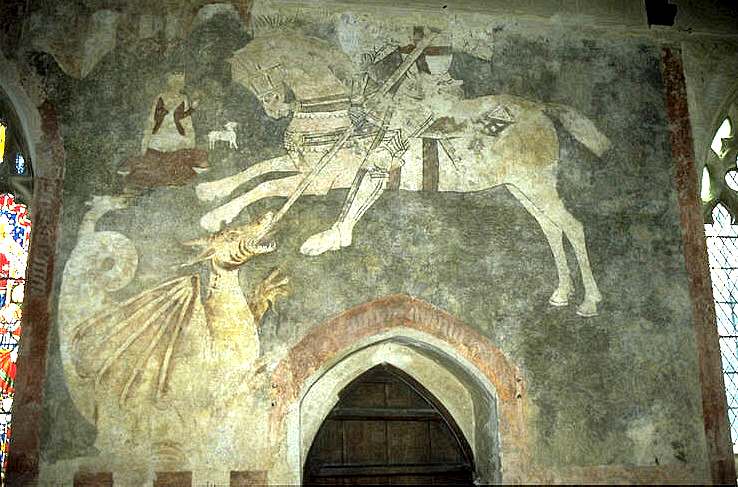Broughton, Buckinghamshire (CCT*) c.1470
St George and the Dragon
“Enfors we us with all our might
To love Seint George, our Lady[’s] knight…
He keped the ma[i]d from dragon’s dred,
And fraid all France and put to flight.
At Agincourt – the crownecle ye red -
The French him see foremost in fight.
In his virtu he wol us lede
Againis the Fend, the f[o]ul wight,
And with his banner us oversprede,
If we him love with all oure might.“ ¹

This incomplete but splendid example of St George fighting the Dragon fills a large area of the south wall at Broughton. The roof was restored and made lower at some time after it was painted in the later 15th century and the head and shoulders of George himself have gone as a result. Medieval artists invariably painted horses well, but here the Dragon too is very stylishly rendered indeed as St George thrusts his spear into its mouth. The saint bears his Red Cross on his shield; his elaborate armour helps to date the painting.
But in any case, probably only after the English victory at Azincourt (Agincourt) in 1415 would St George, who from this point effectively becomes the patron saint of England,² be painted in such bravura fashion – one 14th century painting at Little Kimble in Buckinghamshire even shows him simply standing with spear and shield. George was said to have appeared above the Azincourt battlefield to rally the English troops, whereas in sad fact, of course, the French defeat, in which a huge proportion of the French aristocracy was wiped out, had more to do with the sodden ground and the skill of the unencumbered English longbowmen.
But English medieval church painters, to their credit, concentrated on the original Legend of the Saint in which he defeats a poison-breathing dragon that has been terrorising the neighbourhood and people. The story is in the Golden Legend and Caxton translated and printed it. The Dragon, unappeased by regular offerings of sheep, was eventually given a human victim chosen by lot. She was the king’s daughter. It was at this point in the story that George attacked the Dragon and led it captive with the princess’s girdle. He promised to destroy it completely if king and people would believe in Jesus Christ and be converted, to which condition they agreed.
One of the most interesting features of this painting is the inclusion of the princess, who is shown as a small figure at the left, in front of some faded painted buildings, probably intended for the king’s palace. To the right of her is something that looks like a lamb. If it is, then specific Christian references to the Agnus Dei and the Virgin (the virginal princess went out to meet her fate dressed as a bride) cluster around the story. It is not far from here to the idea of St George as ‘Our Lady’s knight’, an idea which has been amplified by the recent discovery of the painting on the orb of the banner-staff in the Wilton Diptych (National Gallery, London). The inscription there reads – ‘This [England] is your dowry, O holy Virgin, wherefore O Mary, may you rule over it’.³
Other paintings at Broughton include a Doom, a Warning to Swearers, St Helena and St Eloi.
¹ Anon, mid C.15, A carol [with music] of St George, BM. MS Egerton 3307, fol.63b. In RT Davies, Medieval English Lyrics, Faber, 1963, p.185.[Spelling slightly modernised]
² He had been a patron of England since 1222, but had had to share the honour with St Edmund and St Edward the Confessor.
³ E. Langmuir (ed), The National Gallery Companion Guide, 1994, NGL Publications, p.96
* Churches Conservation Trust